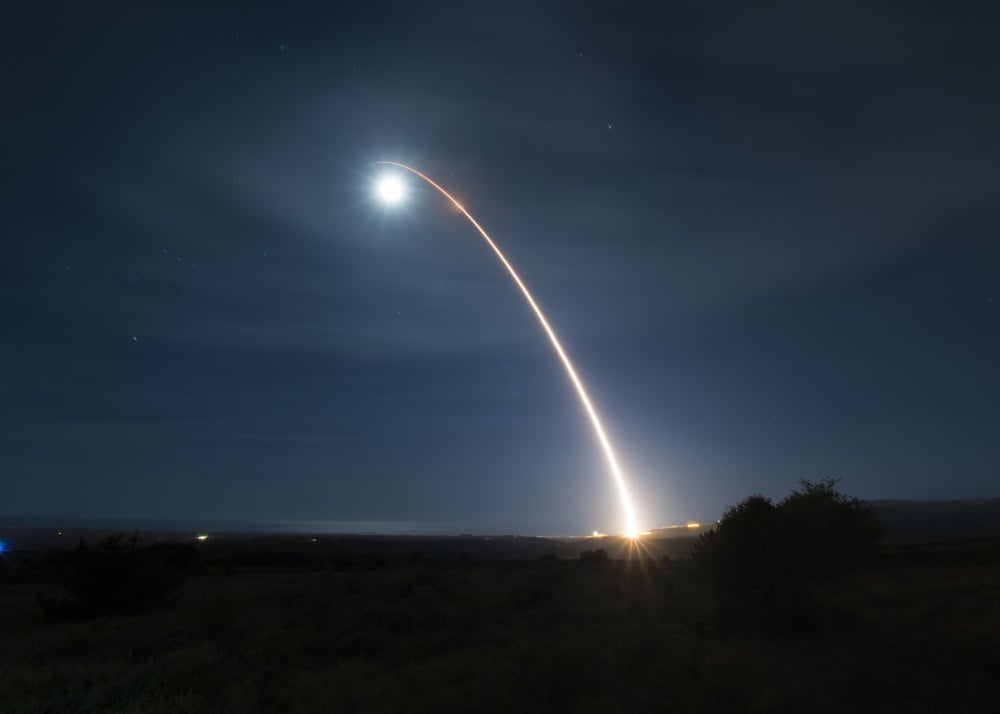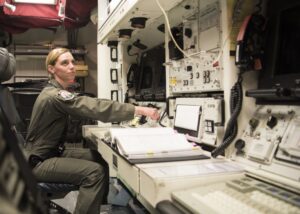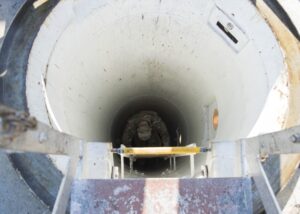
Minuteman III test launch, Vandenberg AFB, Feb. 5, 2020.
VANDENBERG AFB: Rank has its privileges, as I was reminded last night when our bus was waved ahead of the traffic jam to view this morning’s test launch of an unarmed Minuteman III ICBM. The young airman driving the bus shouted out that an 06 (i.e., an Air Force/Army colonel; a Navy captain) was on board and away we went.
Despite the cold, the VIP launch area was crowded. Soldiers, sailors, airmen, contractors and even some family members — with an atmosphere that one media colleague astutely compared to a high school football game, complete with metal bleachers and hot chocolate. We were told that more folks were packed into the Ronald Reagan Missile Defense Site farther away. Since there are only four or five opportunities a year to see the fruits of your labor, it’s not surprising the turnout was so big.
The test itself, dubbed FTU-2, went off relatively cleanly at 12:33 am, with a short 15-minute delay caused by an unexplained anomaly. The missile splashed down some 30 minutes later 4,200 miles away near Kwajalein Atoll in the Marshall islands.
Today’s launch coincides with the one-year countdown to the expiration of the 2010 New START treaty. That was not planned, however, since ICBM test launches are slated years in advance.
But no message was intended. Testing “is not used as a ‘signaling mechanism’ politically,” Col. Omar Colbert, Air Force Global Strike Command’s 576th Flight Test Squadron commander, stressed on Monday.
New START is the only current bilateral treaty that caps US and Russian nuclear weapons. It limits Russia and the US each to no more than 1,550 deployed strategic warheads and 700 deployed strategic delivery vehicles — that is, ICBMs, submarines and bombers). As Breaking D readers know, the Trump Administration has been waffling on whether or not to give the treaty five more years of life.

1st Lt. Claire Waldo, 12th Missile Squadron missile combat crew commander, conducts a dry-run for a test launch in the Launch Control Center Feb. 3, 2020, at Vandenberg AFB.
As I reported yesterday, the “developmental test” was aimed at perfecting a new chemically explosive fuze to set off the Minuteman’s W-87 nuclear warhead. The fuze program, budgeted at just over $2 billion, is expected to reach operational capability in 2024, when replacement of the current fuze in all 400 ICBMs will start. The Minuteman’s replacement, the Ground-Based Strategic Deterrent (GBSD) will be designed with an interface to back-fit the new fuze.
Developmental tests differ from routine operational tests, nicknamed “Glory Trips,” Rather than using a randomly selected ICBM from one of the three operational wings, they use a spare missile from storage that is fitted with the components being tested. Those operational tests are designed to ensure that the ICBMs meet a readiness level that is above 90 percent, Capt. Chris Parmer,
576 Flight Test Squadron Munitions Flight commander, told me yesterday.

ICBM test launch, “Glory Trip,” patches
Such flight tests nonetheless are configured to be as close to real life as possible, and are closely monitored to check normal missile parameters such as functioning of the guidance package.
The flight is closely tracked, according to test team officials here. The missile itself sends telemetry back to the ICBM Telemetry Integrated Processing System (ITIPS), Jerry Rogers, a senior analyst at the Air Force 576 Flight Test Squadron, told reporters last night. It also caries a GPS transmitter tracked by ITIPS, which is one of the newest testing facilities at Vandenberg.
ITIPS was upgraded in 2015 to digitize its operations, Rogers explained. Before that, monitoring data was collected by an enormous mainframe computer that now sits in a museum, he said. In the old system, data was spit out by ancient printers using thermal paper that analysts had to pour over manually.
“We have a lot more resolution now,” Rogers said, “and we can look at the data in a lot more ways.” He added that, needless to say, sharing the test results with users, such as those at Strategic Command, also is a lot easier now that the analysts can simply upload data to a secure website. It will take about a month for the data to be analyzed, he noted.
Ground-based radar in Greenland and Alaska are used to track the missile in flight, officials said. The Navy Pacific Missile Range Facility in Hawaii and the Army Reagan Test Site in Kwajalein also help with the tracking mission. For example, if the missile splashes down on the near side of the atoll — which this test did — its exact landing spot in the sea is monitored by 10 underwater hydrophones operated by the Navy, Capt. Jeff Cumber, the 576th’s chief of tactics, said.
“Developmental testing provides valuable data to Air Force Global Strike Command and Air Force Nuclear Weapons Center for both modernization and sustainment of the ICBM weapon system,” said Colbert.

An Airman from Vandenberg Air Force Base descends into an underground launch equipment room Feb. 3, 2020.
Prior to the launch, one of the most critical factors for giving the thumbs up for the test launch is weather, said Air Force Col. Chris Barcomb, operations group commander for this morning’s launch.
Weather here and at Kwajalein is monitored by a specialized team at the 30th Space Wing’s Western Range Operations Control Center (WROCC). (The 30th Space Wing is now a part of the new Space Force.) Weather specialists use high flying weather balloons, aircraft and weather radar, working closely with the National Oceanographic and Atmospheric Administration’s National Weather Service.
Two key concerns are wind shear, i.e. turbulence, in the upper atmosphere and heavy cloud cover that could result in the launch vehicle actually triggering a lightning strike on itself. The lightning phenomena was first discovered in 1987, when a strike destroyed an Atlas Centaur rocket at Cape Canaveral.
According to officials here, launches have also been delayed because of boats — in one recent incident a lone fisherman — accidentally straying into restricted waters near Vandenberg’s Pacific coast line during the test’s launch window. It’s rare, but it does happen.
The WROCC sends out notices 30 days in advance to airmen and mariners to clear air- and sea-space that will be hazardous during the test launch, and coordinates with the Coast Guard and the Federal Aviation Authority (FAA) to ensure those areas are clear up to the launch, officials here explained. Trains operated by the Union Pacific Railroad that run through Vandenberg via a long-standing right-of-way agreement also are held up by the company for the duration of the flight test.
Launch notifications (NOTAMS) for both ICBM tests and tests of submarine-launched ballistic missiles also are provided via the State Department to foreign governments — including the Russians, under a bilateral agreement dating back to 1988. ICBM test launches fly over the North Pole, so they are tracked by Russian early warning radar. Obviously, no one wants the Russians to mistake a US test for a nuclear attack.
That said, make no mistake, while ICBM tests are not used as specific political responses to adversary actions, they are designed to send a strong general deterrent message: the ground-based leg of the US nuclear triad remains a viable threat. This morning’s ICBM test, said Lt. Gen. Anthony Cotton, AFGSC deputy commander, “is just one of a myriad of activities that we do to ensure that the venerable Minuteman III weapon system will continue to be that viable, long-range leg that’s quick and responsive for the United States of America.”
L3Harris selloffs hampered by low bids, CEO says
“To the extent we can get a good price for what we’ve identified as non-core [businesses], we’ll do it. But too many of the offers are coming in low and people think we’re desperate to sell, and I can assure you we’re not,” said L3Harris CEO Chris Kubasik.


























